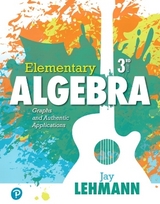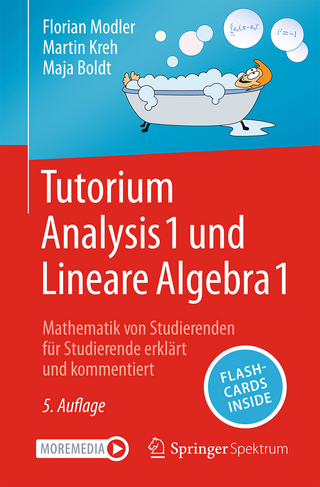
Elementary Algebra
Pearson (Verlag)
978-0-321-86827-5 (ISBN)
- Titel erscheint in neuer Auflage
- Artikel merken
KEY TOPICS: Introduction to Modeling; Operations and Expressions; Using Slope to Graph Linear Equations; Simplifying Expressions and Solving Equations; Linear Equations in Two Variables; Systems of Linear Equations; Polynomials; Factoring Polynomials and Solving Polynomial Equations; Solving Quadratic Equations; Rational Expressions and Equations; More Radical Expressions and Equations; Using a TI-83 or TI-84 Graphing Calculator
MARKET: For all readers interested in algebra.
For more than twenty years, Jay Lehmann has taught at College of San Mateo, where he has received the Shiny Apple Award for excellence in teaching. He has worked on a NSF-funded grant to study classroom assessment and has performed research on collaborative directed-discovery learning. Jay has served as the newsletter editor for CMC3 (California Mathematics Council, Community College) for twelve years. He has presented at more than seventy-five conferences, including AMATYC, ICTCM, and T3, where he has discussed curve fitting and sung his "Number Guy" song. Jay plays in a rock band called The Procrastinistas, who play at various clubs in the San Francisco Bay Area, where Jay, his wife Keri, and son Dylan reside. He plays a number of instruments including bass, guitar, piano, violin, and baritone. In addition to his elementary, intermediate, and combined algebra textbooks, Jay is currently writing a heist novel for high school students, which he hopes will be published before Dylan outgrows it. Dylan, a devoted drummer and artist, drafted many of the cartoons that are included in Jay's textbooks. In the words of the author: Before writing my algebra series, it was painfully apparent that my students couldn't relate to the applications in the course. I was plagued with the question, "What is this good for?" To try to bridge that gap, I wrote some labs, which facilitated my students in collecting data, finding models via curve fitting, and using the models to make estimates and predictions. My students really loved working with the current, compelling, and authentic data and experiencing how mathematics truly is useful. My students' response was so strong that I decided to write an algebra series. Little did I know that to realize this goal, I would need to embark on a 15-year challenging journey, but the rewards of hearing such excitement from students and faculty across the country has made it all worthwhile! I'm proud to have played even a small role in raising peoples' respect and enthusiasm for mathematics. have tried to honor my inspiration: by working with authentic data, students can experience the power of mathematics. A random-sample study at my college suggests that I am achieving this goal. The study concludes that students who used my series were more likely to feel that mathematics would be useful in their lives (P-value 0.0061) as well as their careers (P-value 0.024). The series is excellent preparation for subsequent courses; in particular, because of the curve fitting and emphasis on interpreting the contextual meaning of parameters, it is an ideal primer for statistics. In addition to curve fitting, my approach includes other types of meaningful modeling, directed-discovery explorations, conceptual questions, and of course, a large bank of skill problems. The curve-fitting applications serve as a portal for students to see the usefulness of mathematics so that they become fully engaged in the class. Once involved, they are more receptive to all aspects of the course.
Preface
To the student
Acknowledgments
Index of applications
1. Introduction to Modeling
1.1 Variables and Constants
1.2 Scattergrams
1.3 Exact Linear Relationships
1.4 Approximate Linear Relationships
Taking it to the Lab: Climate Change Lab * Volume Lab * Linear
Graphing Lab: Topic of Your Choice
CHAPTER SUMMARY
Key Points of Chapter 1
Chapter 1 Review Exercises
Chapter 1 Test
2. Operations and Expressions
2.1 Expressions
2.2 Operations with Fractions
2.3 Adding Real Numbers
2.4 Change in a Quantity and Subtracting Real Numbers
2.5 Ratios, Percents, and Multiplying and Dividing Real Numbers
2.6 Exponents and Order of Operations
Taking it to the Lab: Climate Change Lab * Stocks Lab
CHAPTER SUMMARY
Key Points of Chapter 2
Chapter 2 Review Exercises
Chapter 2 Test
Cumulative Review of Chapters 1 and 2
3. Using Slope to Graph Linear Equations
3.1 Graphing Equations of the Form y = mx + b
3.2 Graphing Linear Models; Unit Analysis
3.3 Slope of a Line
3.4 Using Slope to Graph Linear Equations
3.5 Rate of Change
Taking it to the Lab: Climate Change Lab * Workout
Lab * Balloon Lab
CHAPTER SUMMARY
Key Points of Chapter 3
Chapter 3 Review Exercises
Chapter 3 Test
4. Simplifying Expressions and Solving Equations
4.1 Commutative, Associative, and Distributive Laws
4.2 Simplifying Expressions
4.3 Solving Linear Equations in One Variable
4.4 Solving More Linear Equations in One Variable
4.5 Comparing Expressions and Equations
4.6 Formulas
CHAPTER SUMMARY
Key Points of Chapter 4
Chapter 4 Review Exercises
Chapter 4 Test
Cumulative Review of Chapters 1—4
5. Linear Equations in Two Variables
5.1 Graphing Linear Equations
5.2 Finding Linear Equations
5.3 Finding Equations of Linear Models
5.4 Using Linear Equations to Make Estimates and Predictions
5.5 Solving Linear Inequalities in One Variable
Taking it to the Lab: Climate Change Lab * Rope Lab * Shadow
Lab * Linear Equation Lab: Topic of Your Choice
CHAPTER SUMMARY
Key Points of Chapter 5
Chapter 5 Review Exercises
Chapter 5 Test
6. Systems of Linear Equations
6.1 Using Graphs and Tables to Solve Systems
6.2 Using Substitution to Solve Systems
6.3 Using Elimination to Solve Systems
6.4 Using Systems to Model Data
6.5 Perimeter, Value, Interest, and Mixture Problems
6.6 Linear Inequalities in Two Variables; Systems of Linear
Inequalities in Two Variables
Taking it to the Lab: Climate Change Lab
CHAPTER SUMMARY
Key Points of Chapter 6
Chapter 6 Review Exercises
Chapter 6 Test
Cumulative Review of Chapters 1—6
7. Polynomials
7.1 Graphing Quadratic Equations
7.2 Quadratic Models
7.3 Adding and Subtracting Polynomials
7.4 Multiplying Polynomials
7.5 Powers of Polynomials; Product of Binomial Conjugates
7.6 Properties of Exponents
7.7 Negative-Integer Exponents
7.8 Dividing Polynomials
Taking it to the Lab: Climate Change Lab * Projectile Lab
CHAPTER SUMMARY
Key Points of Chapter 7
Chapter 7 Review Exercises
Chapter 7 Test
8. Factoring Polynomials and Solving Polynomial Equations
8.1 Factoring Trinomials of the Form x2 + bx + c and Differences of Two Squares
8.2 Factoring Out the GCF; Factoring by Grouping
8.3 Factoring Trinomials of the Form ax2 + bx + c
8.4 Sums and Differences of Cubes; A Factoring Strategy
8.5 Solving Polynomial Equations
8.6 Using Factoring to Make Predictions with Quadratic Models
CHAPTER SUMMARY
Key Points of Chapter 8
Chapter 8 Review Exercises
Chapter 8 Test
Cumulative Review of Chapters 1—8
9. Solving Quadratic Equations
9.1 Simplifying Radical Expressions
9.2 Simplifying More Radical Expressions
9.3 Solving Quadratic Equations by the Square Root Property; The Pythagorean Theorem
9.4 Solving Quadratic Equations by Completing the Square
9.5 Solving Quadratic Equations by the Quadratic Formula
9.6 More Quadratic Models
Taking it to the Lab: Climate Change Lab * Projectile Lab
CHAPTER SUMMARY
Key Points of Chapter 9
Chapter 9 Review Exercises
Chapter 9 Test
10. Rational Expressions and Equations
10.1 Simplifying Rational Expressions
10.2 Multiplying and Dividing Rational Expressions; Converting Units
10.3 Adding Rational Expressions
10.4 Subtracting Rational Expressions
10.5 Solving Rational Equations
10.6 Proportions; Similar Triangles
10.7 Variation
10.8 Simplifying Complex Rational Expressions
Taking it to the Lab: Climate Change Lab * Estimating p Lab
CHAPTER SUMMARY
Key Points of Chapter 10
Chapter 10 Review Exercises
Chapter 10 Test
11. More Radical Expressions and Equations
11.1 Adding and Subtracting Radical Expressions
11.2 Multiplying Radical Expressions
11.3 Solving Square Root Equations
CHAPTER SUMMARY
Key Points of Chapter 11
Chapter 11 Review Exercises
Chapter 11 Test
Cumulative Review of Chapters 1—11
A. Using a TI-83 or TI-84 Graphing Calculator
A.1 Turning a Graphing Calculator On or Off
A.2 Making the Screen Lighter or Darker
A.3 Entering an Equation
A.4 Graphing an Equation
A.5 Tracing a Curve without a Scattergram
A.6 Zooming
A.7 Setting the Window Format
A.8 Plotting Points in a Scattergram
A.9 Tracing a Scattergram
A.10 Graphing Equations with a Scattergram
A.11 Tracing a Curve with a Scattergram
A.12 Turning a Plotter On or Off
A.13 Creating a Table
A.14 Creating a Table for Two Equations
A.15 Using “Ask” in a Table
A.16 Plotting Points in Two Scattergrams
A.17 Finding the Intersection Point(s) of Two Curves
A.18 Finding the Minimum or Maximum of a Curve
A.19 Finding any x-Intercepts of a Curve
A.20 Turning an Equation On or Off
A.21 Finding Coordinates of Points
A.22 Entering an Equation by Using Yn References
A.23 Responding to Error Messages
Answers to odd-numbered exercises
Index
| Erscheint lt. Verlag | 12.2.2014 |
|---|---|
| Sprache | englisch |
| Maße | 10 x 10 mm |
| Gewicht | 1551 g |
| Themenwelt | Mathematik / Informatik ► Mathematik ► Algebra |
| ISBN-10 | 0-321-86827-7 / 0321868277 |
| ISBN-13 | 978-0-321-86827-5 / 9780321868275 |
| Zustand | Neuware |
| Informationen gemäß Produktsicherheitsverordnung (GPSR) | |
| Haben Sie eine Frage zum Produkt? |
aus dem Bereich



